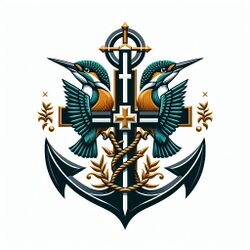Metaorizonal
| This article is a stub. You can help IxWiki by expanding it. |

| This article is part of a series on the |
| Burgoignesc Security Forces |
|---|
 |
| Military |
| Law Enforcement |
| Alliances and Cooperative Units |
| History and culture |
| Organization and Structure |
| Strategy and Defense Policies |
| Current Initiatives |
| Key Suppliers and Partnerships |
|
Burgundie portal |
Metaorizonal (Burgoignesc: Beyond the horizon) is a school of naval military thought pioneered and espoused by the nation of Burgundie and its navy. It has since been adopted by many great and second-rate naval powers globally, and is one of the primary branches of modern naval thinking alongside air group dominance, green water defense and support, and submarine infiltration doctrines.
Metaorizonal as the specific doctrine of the Navy of Burgundie emphasizes control of the information space surrounding a battlefield through the use of satellite tracking and communications support, high-fidelity, long distance radar systems, and powerful ultra high-range, high-confidence, and defense-breaching missile capabilities. Whereas navies centered around their air wings or submarine wings invest heavily in stealth capabilities, Metaorizonal and its descendant doctrines accept that, for technical or cost reasons, cutting-edge stealth technologies are not feasible. Instead, such navies offset the vulnerabilities of potential engagement with more stealth-capable enemy forces through extreme-ranged fires and ideally unparalleled situational awareness.
Metaorizonal doctrines have the added benefit of being accessible even at small tonnages, though in the case of the smallest ships, larger dedicated 'squadron task leaders' are required to conduct effective command and control. This means the Burgundine navy in particular is capable of fielding a large number of small warships globally, enabling rapid regional assembly of naval brigade combat teams to support capital assets such as carriers or amphibious assault groups. This reduces the administrative and supply burden of massing warships and allows for greater resilience in the face of warship casualties.
Further improvements
Operation Cavum Fundamentum
Operation Cavum Fundamentum (OCF), the naval initiative of the 21st Century Burgoignesc Power Projection Stratagem, pointedly bolsters the Navy of Burgundie's execution of the Metaorizonal doctrine.
At the forefront of these technical strides is the fleet modernization purchasing plan, focusing on procurement of smaller vessels, meticulously designed for agility and rapid response. The re-introduction of smaller aircraft carriers complements this strategy, creating nimble strike groups capable of deploying globally within a mere 48 hours. This aligns seamlessly with the Metaorizonal doctrine's emphasis on rapid response and distributed force structures.
OCF's concept of "stone carriers", transforming island Naval shore facilities into integral components of the fleet defense plan, takes advantage of the developments in flight endurance of smaller airframes. This strategic integration, backed by meticulous geographical analysis and technological optimization conducted by the HERMES Collaborative Combat Network, positions these facilities as robust elements in the Navy's defensive and offensive arsenal. The technical intricacies of this transformation involve a fusion of surveillance technologies, real-time communication systems, and strategic planning algorithms to ensure cohesive and adaptive alert and warning as well as deep strike capabilities.
Operation Cavum Fundamentum then dives into the airspace with a revival of flying-boats, injecting versatility into embarkation and disembarkation options. The technical specifics of this initiative include the reintroduction of submarine flying-boat tenders, creating a dynamic platform for sea basing capabilities and establishing submarine-to-flying-boat personnel and equipment transfer capabilities. These advancements not only embrace the Metaorizonal doctrine's focus on offsetting vulnerabilities but also introduce a novel dimension to naval operations, increasing adaptability in deployment scenarios.
Ultra-long-range patrol capabilities take center stage, deploying Avisos equipped with state-of-the-art surveillance technologies. These vessels become the eyes and ears of the Navy, extending surveillance capabilities to cover expansive maritime territories. The technical intricacies involve advanced sensor arrays, satellite communication systems, and predictive analytics algorithms to ensure optimal coverage and response times.
As the digital battleground becomes increasingly pronounced, Operation Cavum Fundamentum fortifies the Navy's cyber defenses. The hardening of communications and information-sharing vectors involves cutting-edge encryption technologies, intrusion detection systems, and continuous cyber threat assessments. These technical fortifications serve as a bulwark against cyber vulnerabilities, aligning with the Metaorizonal doctrine's recognition of the importance of securing the information space.
Advanced drone integration
Integrating advanced drone warfare into the Metaorizonal doctrine significantly enhanced its effectiveness. Unmanned aerial vehicles (UAVs) and unmanned surface vessels (USVs), and other autonomous tracking and weapons systems augment the existing emphasis on information control and long-range capabilities. Advanced drones equipped with high-resolution sensors extend the []Navy of Burgundie]]'s surveillance range, providing real-time intelligence and enhancing situational awareness over a larger area, complementing satellite and radar systems. Drones with stealth capabilities can operate in close proximity to the enemy in contested environments, infiltrating adversary defenses, and gathering critical information without exposing larger, manned assets. UA s and USVs aid in identifying and classifying potential threats, helping the Navy make informed decisions on engagement. Additionally these automated vehicles and sensors can act as force multipliers, allowing a smaller fleet to cover a larger operational area effectively. They serve as communication relays and guidance platforms for ultra-long-range missiles, improving the coordination of missile strikes. Drones equipped with electronic warfare systems can disrupt adversary communications and radar systems, further establishing control over the information space and degrading the effectiveness of opposing forces.
HERMES
The introduction of the HERMES Collaborative Combat Network into the Navy of Burgundie marks a significant technological leap, synergizing seamlessly with the Metaorizonal naval doctrine to enhance the Navy's operational capabilities and information control.
HERMES functions as the neural network of the Navy, interlinking ships, satellite systems, and surveillance assets in real-time. This link directly provides a major step forward in the Navy's emphasis on achieving total situational awareness. Through HERMES, the Navy gained an extensive information grid, receiving constant updates on the maritime environment, potential threats, and the status of allied and adversarial forces. Satellite tracking, a key component of Metaorizonal strategy, is optimized through HERMES, providing precise and continuous monitoring of naval assets and potential areas of engagement. This elevated level of surveillance contributes to the Navy's ability to dominate the information space surrounding the battlefield, a core tenet of the Burgoignesc way of war.
Using HERMES, communication within the naval force becomes instantaneous and secure, allowing for swift coordination and execution of maneuvers. Commanders at all levels, equipped with a common operating picture facilitated by HERMES, can make strategic and tactical decisions based on real-time data, optimizing the deployment of naval assets in response to evolving threats. HERMES also plays a pivotal role in the coordination of long-range missile capabilities. The network ensures that targeting information is swiftly and accurately relayed, maximizing the effectiveness of the Navy's firepower at extreme ranges.
When operations require the rapid assembly of naval brigade combat teams, like during the 2032 Yanuban Coup, HERMES streamlines the process, running a diagnostic assessment of the readiness of all ships and teams in the Navy and facilitating the deployment of the fastest, most cost effective teams that have the exact skills that are predicted to be needed. The network's efficiency reduces administrative and supply burdens, enabling the Navy to adapt swiftly to regional developments and support larger capital assets.
Furthermore, the integration of railgun and laser technology, a component of the Metaorizonal doctrinal evolution, benefits from HERMES connectivity. Targeting information is seamlessly transmitted, allowing for rapid and precise railgun or laser system engagements over extended distances.
The HERMES Collaborative Combat Network became the digital backbone of the Navy of Burgundie's Metaorizonal doctrine. Its real-time connectivity, information flow, and coordination capabilities not only amplify the doctrine's core principles but also position the naval force at the forefront of technologically driven maritime superiority despite its small size, compared to Caphiria, Kiravia, or Urcea.
Lasers and rail guns
The integration of cutting-edge laser weapons into the Metaorizonal doctrine has brought about a revolution in ultra-long-range capabilities, uninterceptability, and continuous fires. The CYCLOPS laser weapons system offers near-instantaneous target engagement, providing a rapid response capability. While it very expensive to develop but it has been determined to be a cost-effective and efficient defense against incoming anti-ship missiles and the cost per engagement is proving to be lower than traditional munitions. The speed of light allows for quick target acquisition and interception, improving the naval force's ability to counter missile threats and enhancing overall survivability. Unlike traditional munitions, the CYCLOPS' laser beams are silent and leave no visible projectile, reducing the ability of even the most advanced ship defense systems to intercept the beam. CYCLOPS has a sustained engagement capability without the need for frequent resupply beyond a sustained power supply. The CYCLOPS laser systems can effectively counter unmanned aerial vehicles and drones. This is particularly relevant in a naval context, where more countries regardless of blue-water capability are developing or buying low-cost drones that they are employing for surveillance, reconnaissance, or even as potential threats. Laser weapons provide a flexible and efficient means of neutralizing these targets. The compact size of the CYCLOPS allows it to be integrated into a variety of platforms, including both large capital ships and smaller vessels. This adaptability allows for a distributed force structure, aligning with the doctrine's capability to field a large number of small warships globally.
The Navy of Burgundie, pioneering the adoption of railguns, found a strategic advantage in the extended reach and firepower these electromagnetic weapons offer. The railguns' ability to launch projectiles at hypervelocity speeds over vast distances is becoming a cornerstone of the Metaorizonal doctrine. Naval vessels of all sizes, equipped with railguns, are gaining a formidable capability for extreme-ranged fires, enabling precision strikes against distant targets with unparalleled speed. Moreover, the railgun's electromagnetic propulsion system minimizes the need for traditional propellants, resulting in a reduced logistical burden and extended operational endurance. This supports the Navy of Burgundie's 21st Century Burgoignesc Power Projection Stratagem goals of creating a distributed and resilient naval force capable of sustained, long-duration operations.
As laser and railgun technology continue to mature, the Navy of Burgundie find itself at the forefront of this paradigm shift in naval warfare. This doctrine, empowered by the inclusion of cutting-edge lasers and railgun technology, continues to cement its status as a forward-thinking and dynamic naval strategy, poised to meet the challenges of modern maritime conflict with unprecedented precision and power against both near-peer and asymmetrical adversaries.
Faneria
The Fhainnin navy has experimented with a variety of fleet doctrines since the 1970s, and was generally receptive to Metaorizonal as originally envisioned at its start. Research and development efforts in Faneria have centered heavily on the specific technologies required to effectively and proficiently achieve Metaorizonal's ideal performance, namely in electronic warfare methods, advanced missile targeting and defeat-of-defense systems, and most recently a growing self-operated strategic satellite array. This has been expanded upon in recent decades through a addition of emphasis on simultaneous surface-air strike drills, allowing slower, longer-range land and ship-based missiles to be complimented by faster air-launched missiles, allowing for either a singular, massive strike or a series of strikes intended to systematically expend an opposing force's own defensive missiles.
Caphiria
Caphirian naval doctrine is by necessity spread across surface warfare, coastal landing and defense, and submarine infiltration and interdiction concerns. The Imperial Navy fields a large count of corvette, frigate, and destroyer-type vessels, typically centered on antisubmarine, mine and countermine, or missile warfare. Caphirian combat squadrons typically operate on a degree of Metaorizonal-adjacent tactics, though the Caphirian navy is primarily geared towards fast missiles rather than extreme range. Caphiria has demonstrated high capabilities in the information domain, but defense industry papers and statements by officials indicate that Caphiria's naval composition is centered on the efficacy of its submarine forces above all else.
See Also